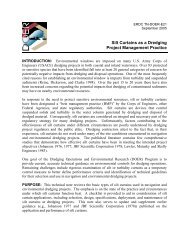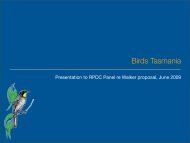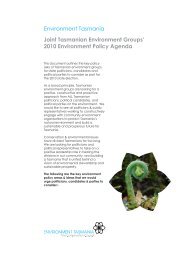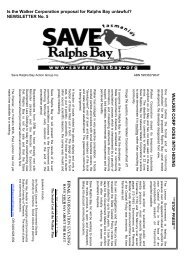Jane MacDonald - Save Ralphs Bay
Jane MacDonald - Save Ralphs Bay
Jane MacDonald - Save Ralphs Bay
Create successful ePaper yourself
Turn your PDF publications into a flip-book with our unique Google optimized e-Paper software.
Australia have been weather related. Climate change exacerbates extreme weather events<br />
and reduces the ability to spread risk.<br />
p.136. Australians continue to flock to the coast. Rapid and ongoing population growth in<br />
coastal areas in the past few decades, which has led to the construction of more<br />
infrastructure and greater pressure on coastal ecosystems, has also increased the level of<br />
national risk to climate change impacts. Amenity migration is expected to continue for the<br />
next 15 years as baby boomers retire to coastal areas. To cater for this growth, developers<br />
increasingly purchase land in the coastal zone and seek rezoning for greenfield<br />
subdivisions. Some of this development is in low‐lying land areas, and some development<br />
reflects the growing popularity of canal estate developments. Unless there are constraints<br />
on such land use decisions, made now and over the next few years, climate change<br />
impacts will exacerbate the risks property owners and governments face in the future.<br />
These and other decisions made in recent decades increase the vulnerability of the<br />
Australian community to the impacts of climate change.<br />
p.137. Governments at all levels also need to be aware of the potential future costs of<br />
natural disasters, which currently cost around $1 billion per year on average. Many extreme<br />
weather events occur in the coastal zone, and climate change will increase their frequency<br />
and severity, possibly exponentially (see Chapter 2). This could mean that the costs of<br />
natural disasters could double or more in the next few decades. Intervention to constrain<br />
increases in exposure to such hazards would be of economic and social benefit. The<br />
combination of large and increasing risk from climate change in the coastal zone, the<br />
making of basically irreversible decisions on long‐lived assets, and the lag effect in action<br />
to reduce risk indicate a need for early adaptation in many cases.<br />
p.141 • adopt the precautionary principle and avoid actions that will make it more<br />
difficult to cope with climate risks in the future<br />
• make more conscious decisions about the extent to which risks are being transferred to<br />
future generations, and the basis on which tradeoffs between the built and natural<br />
environment are made<br />
6.3.2 Guidance for risk management<br />
Adaptation planning should be developed on the basis of the best science and be updated<br />
periodically as new science becomes available. As outlined in Chapter 2, atmospheric and<br />
oceanic evidence for climate change is pointing more and more to what had previously<br />
been perceived as worse‐case rates and extent of sea‐level rise, ocean temperature<br />
warming, changes in rainfall and runoff patterns, and the intensity and distribution of<br />
extreme events. In the light of that evidence, it is appropriate to clarify national<br />
frameworks and standards to address risk from climate change impacts in the coastal zone.<br />
<strong>Jane</strong> <strong>MacDonald</strong>, submission on DIAR Page 15







